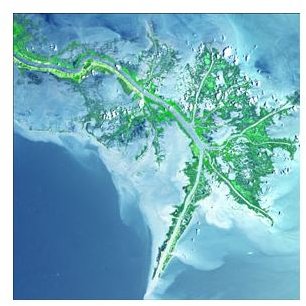What Is a River Delta and How Is it Formed
Historical Roots
What is a river delta and how did it get its name? The Greek historian Herodotus first used the term “delta” for the unique triangular area at the mouth of the Nile River. He likened the triangular shape of the silt deposits to the Greek letter Delta and the name stuck.
How a Delta Is Formed
A river delta forms when the fast moving river water enters a larger, slower moving body of water. As the current slows, it is unable to keep pulling the silt that it is carrying down the river any further. The silt starts to drop away. Because the water coming down the river spreads out equally in all directions, a fan shape forms at the mouth of the river. This fan shape (similar to a triangle) builds up as more and more sediment is deposited.
Parts of a Delta
A delta is comprised of four distinct regions: the subaqueous, subaerial, lower delta plain and upper delta plain.
Subaqueous – This is the portion of the delta that remains below the low tide mark. It is comprised of very fine silt that decreases in size the further away from the mouth of the river you get.
Subaerial – This area is above the low tide mark and consists of various sized sand and rock that is constantly in flux due to the actions of the tidal force.
Lower Delta Plain – This is where the river water flows into the larger body of water. Silt deposit formations are subject to both river current and tidal forces.
Upper Delta Plain – This is the starting point of the delta, and the silt here consists of the largest particles. There is relatively little impact from the large body of water or its forces here.
Types of Deltas
Wave dominated – A wave dominated delta begins as a standard wave shape, and then the waves from the tide start to drag away the outer edge of the fan. Because of the linear shape of the outgoing tide, the edge of the delta that is drawn away looks like a straight line. This, coupled with the fanning shape of the initial delta, creates the classic triangular shape.
Tide Dominated (Bird’s Foot) – A tide dominated delta is often fully covered by the tide as it comes in. The smaller, lighter silt is dragged out into the large body of water leaving sand bars of larger silt particles. When the tide is out, the dendrite structure of the remaining delta can be seen. There are usually several small branches that the river follows through the sand bars to the larger body of water.
Gilbert – Gilbert deltas are formed when a freshwater river runs into a large freshwater lake. These deltas have coarser silt than freshwater or sea water deltas as the water mixes more quickly and the lighter silt is thrust out into the lake quicker. In the seawater deltas, the freshwater is less dense and stays on top of the seawater for longer making it easier for silt to trickle through.
Cuspate – A cuspate delta is tooth shaped. These form where there is significant tidal force for equal and opposite directions. Although rare, they do occur on very large bodies of water. A good example is the Tiber River in Italy; its delta in the Mediterranean Sea.
Delta Life Cycle
A delta will either eventually reach a state of equilibrium between river deposits and tidal forces or will enter a cycle of progradation and transgression in which it grows and recedes based on the cyclical nature of the river system (i.e. floods, spring river runs, etc.).
Stagnate – This is the term for a delta that has reached equilibrium.
Prograde – A prograde delta is one in which the depositing of silt outweighs the tidal force dragging it away. These deltas grow outward into the large body of water until equilibrium is achieved.
Aggrade – An aggradation occurs when the delta starts to accumulate biomass. This can be from plant growth or from the collection of decaying organic material collected from the tides. These deltas grow upwards instead of outwards.
Transgression – A delta in transgression is receding from the sea. The tidal force is stronger than the river and thus pulls away more silt than is being deposited.
Where a river delta begins and where it ends are always approximations. To determine what is a river delta and what is not would require consistent monitoring of silt deposits. Because this is impractical, the area that is considered the beginning of a delta usually is determined by the coastline surrounding the river while the end of the delta is determined by the reach of the sediment deposits at low tide.
Of course, these are just estimates and the lower delta plain almost always extends past the low tide region, but there is no way to determine where it ends and the sea floor begins. There is simply a transitional area. In any case, the important thing is that the river delta is a transitional space between the river and the larger body of water.
References
Author unknown, “River Delta”, https://www.americaswetlandresources.com/background_facts/detailedstory/RiverDelta.html
Author unknown, “The Mississippi River Delta”, https://www.nationalatlas.gov/articles/geology/features/delta.html
Image courtesy of NASA
